Around the world, there are several types of turkeys to choose from. However, there are many fewer breeds of turkey than there are of chicken or duck. Nonetheless, there are still enough options available.
Certain turkey varieties are suitable for rearing as pets, while others are useful for improving the aesthetics of your house. Some of these types are good for producing meat for commercial purposes. Most farmers used to grow turkeys for meat production on a commercial basis.
Selecting the appropriate breed of turkey is a crucial choice that may greatly influence your performance in the commercial turkey farming industry.
The numerous varieties of turkey breeds and their traits will be covered in this book, along with the top turkey breeds for a variety of uses. I hope you find this article useful!
The Top 10 Types of Turkeys
Turkey breeds are a great option for home farmers, commercial producers, and enthusiasts alike since they come in a variety of sizes, colors, and qualities.
The Narragansett, Bourbon Red, Broad Breasted White, Royal Palm, Bronze, and White Holland are a few of the most popular breeds of turkey.
While the Narragansett is renowned for its peaceful nature and aptitude for foraging, the Broad Breasted White is prized for its size and effectiveness in producing meat.
The Royal Palm is a minor breed used for ornaments, but the Bourbon Red has a beautiful look and great flavor.
The White Holland is a well-liked option for home farming and meat production, while the Bronze is a heritage breed with exceptional meat quality and hardiness.
You have to become familiar with the different breeds of turkeys. Here, we’ll give a brief description of a few widespread and well-liked turkey breeds along with their traits.
1. Beltsville Small White Turkey

In the 1930s, Beltsville little white turkeys were created. Their sizes are comparable to those of the Midget Whites. However, compared to Midget White turkeys, Beltsville little white turkeys have broader breasts.
Although they are less colorful than Midgets or certain other heritage birds, little white Beltsville turkeys are nonetheless a good table bird.
Mature chickens are excellent sitters and competent egg hatchers, and they lay a lot of eggs. However, in contrast to other historical turkey breeds, they lack social graces.
2. Black Turkey
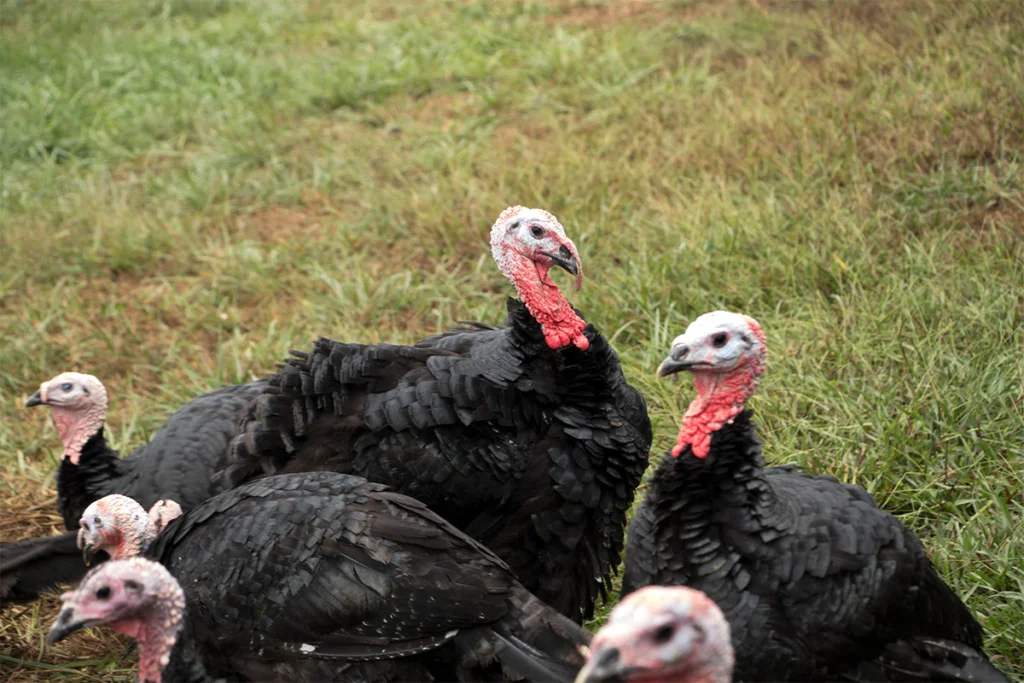
One domestic breed of turkey is the black turkey. The first Spanish explorers to visit the United States transported wild turkeys from Mexico back to Europe, where they were tamed. Since the 1500s, black turkeys have existed, and their feathers are black. This breed may be found in several European countries.
3. Blue Slate Turkey

One domestic turkey breed is called Blue Slate. Their plumage is slate gray in hue. They are also known as lavender turkeys and are lighter-colored birds.
In reality, the slate turkey breed can have any combination of white and pure black coloring. They belong to the lovely heritage breeds of turkeys. A mature Blue Slate hen weighs around 14 pounds, while an adult tom weighs approximately 23 pounds.
4. Turkey Bourbon
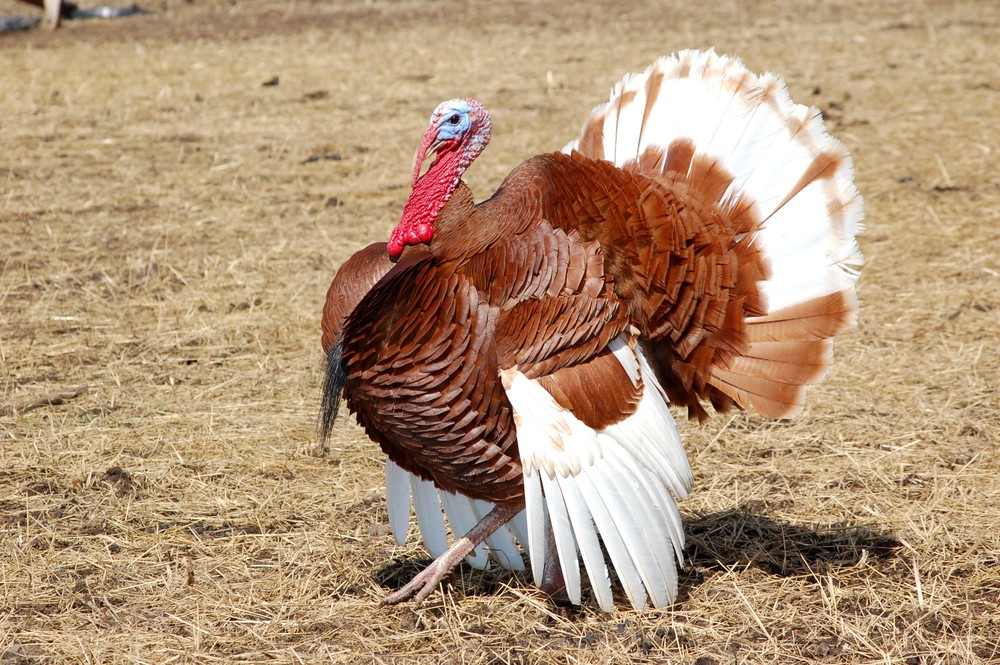
Because of their stunning red feathers, Bourbon Red turkeys are highly appealing birds. They are regarded as one of the best-tasting heritage turkey breeds and are well-known for their rich flavor and succulent flesh.
This breed originated in Kentucky’s Bourbon County. It was in the 1800s when they were first bred there. A mature tom can weigh up to 23 pounds, while a mature Bourbon hen weighs around 12 pounds.
5. White Turkey with Broad Breasted

The contemporary breed of turkey produced on farms for commercial purposes is the broad-breasted white turkey. They are accessible in nearly every nation on the planet.
Similar to broiler chicken varieties, they have the highest feed-to-meat conversion ratio in the quickest amount of time, making them ideal for industrial turkey farming. However, there are a few issues with White Broad-Breasted Turkeys.
Nor can they walk or fly. Like other poultry birds reared in industrial farms, they are susceptible to illnesses and require artificial insemination to breed. Moreover, their flavor is not as good as that of other turkey breeds. They are solely appropriate for manufacturing purposes in factories and farms.
6. Midget White Turkey

Miniature White heritage turkeys are a relatively recent breed. In the 1960s, scientists at the University of Massachusetts created this breed of turkey. They are a hybrid of the royal palm and the broad-breasted white. They have a rich, flavorful flavor and are smaller in size.
Due to the small size of the Midget White hens, who can become skilled fence jumpers, Midget White turkeys have a serene disposition and are adept at rearing poults. Mature Midget White hens often weigh between 8 and 12 pounds, while mature toms typically weigh between 16 and 20 pounds.
7. Narragansett Turkey
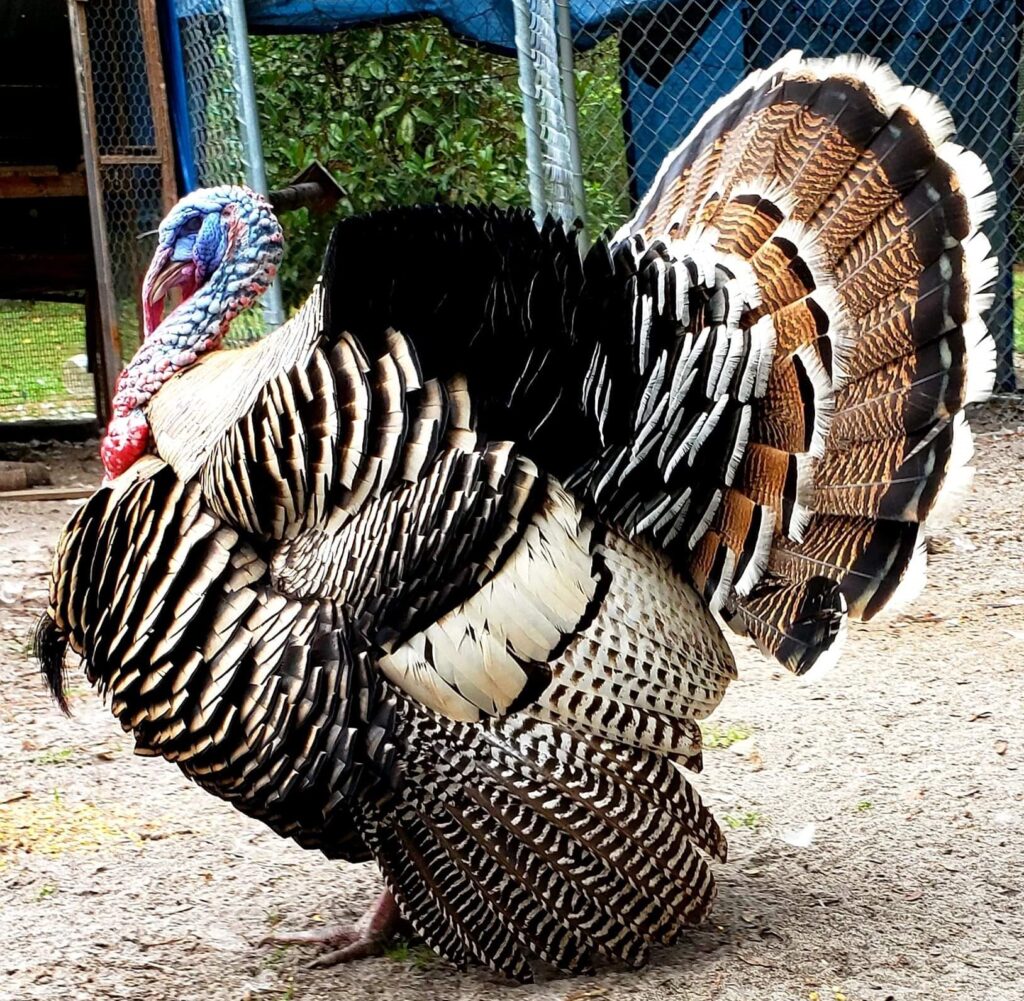
Because they are originated from Rhode Island, Narragansett turkeys were the mainstay of the New England turkey scene before factory farmed turkeys became the standard. Mature Narragansett hens weigh around 18 pounds, while toms weigh approximately 30 pounds on average.
8. Typical Bronze Turkey
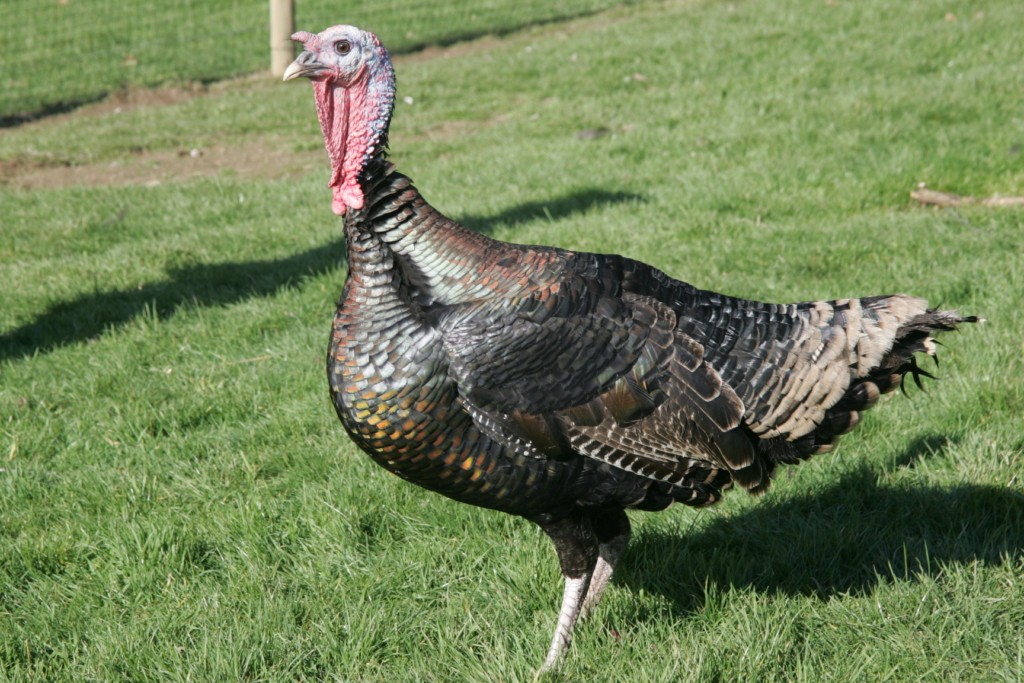
One of the biggest breeds of heritage turkeys is the Standard Bronze turkey. In American history, these have also been the most widely used breeds of turkeys. Originally, bronzes were a cross between the American wild turkeys that were endemic to the continent and the turkeys that European settlers brought with them to the colonies.
The Broad-Breasted Bronze is the most commercially grown type of Standard Bronze, and since the 1960s, the majority of these variations have been created using artificial insemination. However, at that time, the Broad-Breasted White took the place of this type.
Because the Broad-Breasted’s white feathers White turkeys have become the most commercially acceptable variety of turkey and have a cleaner appearance.
A mature hen weighs around 16 pounds on average, whereas a tom may weigh up to 25 pounds. That being said, modern birds could be smaller than these.
9. Royal Palm Turkey

The Royal Palm turkey breed is incredibly stunning and eye-catching. In actuality, their attractiveness was bred into them. Their plumage is black and white. Their breeding was not done for profit.
Due to their lower size compared to the majority of other heritage kinds. Most often, they are raised for show or to improve the aesthetics of a house or farm.
Nonetheless, they are appropriate for producing meat for household consumption. The Royal Palm breed of turkeys is an energetic one that forages widely, has strong bug control, and can fly well. About 10 pounds makes up a Royal Palm hen, while about 16 pounds makes up a tom.
10. White Holland Turkey
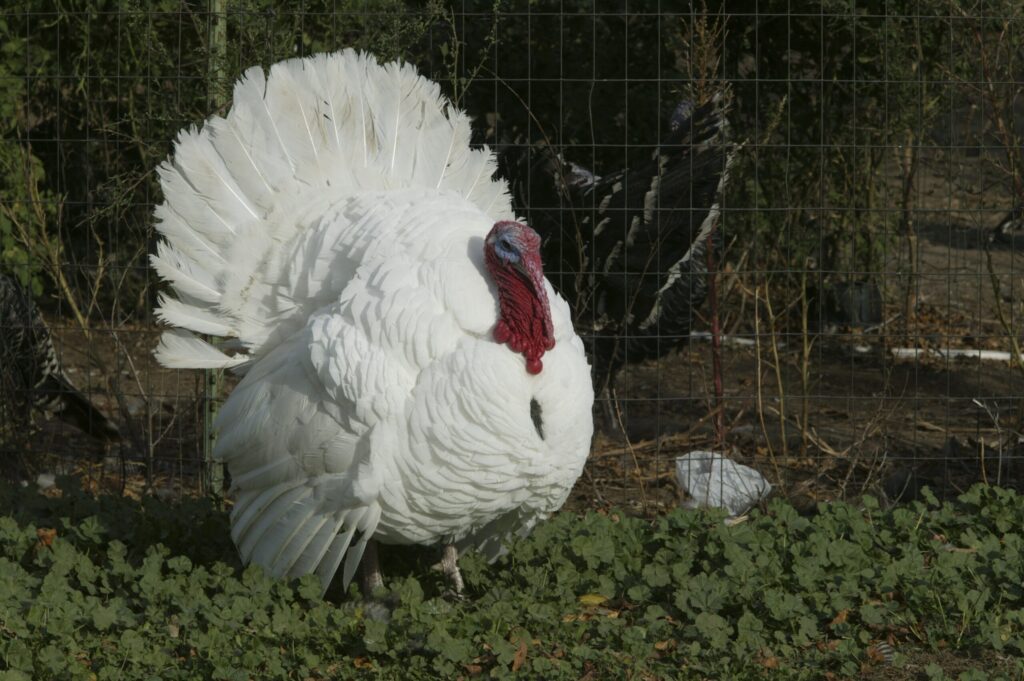
Holland is the home of white Holland turkeys. Along with the first immigrants to the USA, this breed of turkey came there. In the 1800s, they were also widely used as meat birds. White Holland turkeys are peaceful creatures that make excellent moms and setters.
However, because the hens are so hefty, occasionally they crack their eggs. Mature White Holland toms and hens can weigh up to 30 pounds and 20 pounds, respectively.
Why Is Selecting the Correct Breed of Turkey Important?
Selecting the ideal breed of turkey has a significant impact on your farm’s output and earnings. Certain breeds have unique traits (taste, texture, and growing rate of meat, for example). Additionally, choosing a breed that complements your tastes and goals will guarantee optimum revenue and high productivity.
How Do You Choose the Best Breed of Turkey for Your Farm?
Choosing the ideal breed of turkey for your farm is yet another crucial undertaking. A decent breed choice for your farm should take your objectives and available resources into account. Ascertain the objective of your production (meat, eggs, or both) for the turkeys. Think about the available space and the temperature where you live.
While Bourbon Reds are historical breeds and are prized for flavor, Broad Breasted Whites are great for meat. Make an effort to find out the bird’s dimensions, pace of growth, and degree of environmental adaptation. In addition, you may seek advice from some local specialists when selecting the best breeds for your farm.
Conclusion
In conclusion, understanding the various types of turkeys and their unique characteristics is vital for anyone involved in turkey farming, whether for commercial purposes or as a hobby. From heritage breeds like the Bourbon Red and Narragansett to modern varieties like the Broad Breasted White, each type of turkey offers distinct advantages and considerations.
Selecting the right breed can significantly impact farm productivity and success, taking into account factors such as desired outcomes (meat, eggs, or both), available resources, and environmental conditions. By evaluating traits such as size, growth rate, and adaptability, farmers can make informed decisions to maximize profitability and meet their goals in turkey farming.
Frequently Asked Questions (FAQs) About Turkeys
Which breed of turkey is most prevalent?
The Broad Breasted White breed of turkey is the most popular in the world. It’s well-liked for its thicker thighs and plenty of breast meat; its white feathers make it easy to identify. The main purpose of commercial turkey farms is to produce meat from these animals.
How many types of turkeys do we have?
The American Poultry Association recognizes eight turkey types/varieties, all considered heritage varieties: Standard Bronze, Beltsville Small White, White Holland, Bourbon Red, Narragansett, Slate, Black, and Royal Palm.
What is the best tasting turkey breed?
The Midget White turkey is considered the best-tasting breed, followed by the Bourbon Red.
What is the rarest turkey breed?
The Light Brown or Auburn turkey is the rarest domestic breed.
What breed of turkey do we eat?
The Broad Breasted White is the most common and popular breed raised for commercial meat production.
What is the smallest turkey breed available?
The Midget White is the smallest breed of turkey currently available.
What breed of turkey is easiest to raise?
The Broad Breasted White, also known as the ‘Giant White Turkey,’ is the easiest breed to raise, widely preferred in commercial turkey farming.
What is the oldest breed of turkey?
The White Holland is the oldest known turkey breed.
Which breed of turkey costs the most money to purchase?
The priciest turkey breeds to buy include Black Spanish, Narragansett, Jersey Buff, and KellyBronze.
Which kind of turkey is ideal for raising for meat?
The finest breed for producing meat is the Broad Breasted White, which is frequently bred in industrial turkey farms.
What breed of turkey can breed naturally?
Most turkey breeds are capable of natural breeding.
Are chocolate turkeys rare?
Yes, Chocolate turkeys with brown feathers, shanks, and feet are very rare.
Which turkey breed lays the most eggs?
The Bourbon Red turkey is known for laying between 90 and 120 eggs annually.
What is the biggest heritage turkey breed?
The Standard Bronze is one of the largest heritage turkey breeds.
Is there a breed of white turkey?
Yes, several breeds of white turkeys exist, including Broad Breasted White, Beltsville Small White, Midget White, and White Holland.
What breed of turkey is grey?
The Slate, or Blue Slate, turkey is known for its slate gray plumage.
Is there a breed of black turkey?
Yes, the Norfolk Black, also known as the Black Spanish or Black Turkey, is a black-colored domestic turkey breed.
What is turkey farming?
Turkey farming involves raising domestic turkeys for meat and egg production, a profitable business with increasing popularity.
How do you start a turkey farming business?
Starting a turkey farming business involves selecting a good breed, providing suitable shelter, ensuring nutritious food, and providing proper care for the birds. It’s a relatively simple and straightforward process.
